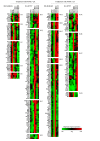Enhancement of ATRA-induced differentiation of neuroblastoma cells with LOX/COX inhibitors: an expression profiling study
- PMID: 20459794
- PMCID: PMC2874523
- DOI: 10.1186/1756-9966-29-45
Enhancement of ATRA-induced differentiation of neuroblastoma cells with LOX/COX inhibitors: an expression profiling study
Abstract
Background: We performed expression profiling of two neuroblastoma cell lines, SK-N-BE(2) and SH-SY5Y, after combined treatment with all-trans retinoic acid (ATRA) and inhibitors of lipoxygenases (LOX) and cyclooxygenases (COX). This study is a continuation of our previous work confirming the possibility of enhancing ATRA-induced cell differentiation in these cell lines by the application of LOX/COX inhibitors and brings more detailed information concerning the mechanisms of the enhancement of ATRA-induced differentiation of neuroblastoma cells.
Methods: Caffeic acid, as an inhibitor of 5-lipoxygenase, and celecoxib, as an inhibitor on cyclooxygenase-2, were used in this study. Expression profiling was performed using Human Cancer Oligo GEArray membranes that cover 440 cancer-related genes.
Results: Cluster analyses of the changes in gene expression showed the concentration-dependent increase in genes known to be involved in the process of retinoid-induced neuronal differentiation, especially in cytoskeleton remodeling. These changes were detected in both cell lines, and they were independent of the type of specific inhibitors, suggesting a common mechanism of ATRA-induced differentiation enhancement. Furthermore, we also found overexpression of some genes in the same cell line (SK-N-BE(2) or SH-SY5Y) after combined treatment with both ATRA and CA, or ATRA and CX. Finally, we also detected that gene expression was changed after treatment with the same inhibitor (CA or CX) in combination with ATRA in both cell lines.
Conclusions: Obtained results confirmed our initial hypothesis of the common mechanism of enhancement in ATRA-induced cell differentiation via inhibition of arachidonic acid metabolic pathway.
Figures

Similar articles
-
Influence of LOX/COX inhibitors on cell differentiation induced by all-trans retinoic acid in neuroblastoma cell lines.Int J Mol Med. 2010 Feb;25(2):271-80. Int J Mol Med. 2010. PMID: 20043138
-
The ATRA-induced differentiation of medulloblastoma cells is enhanced with LOX/COX inhibitors: an analysis of gene expression.Cancer Cell Int. 2014 Jun 13;14:51. doi: 10.1186/1475-2867-14-51. eCollection 2014. Cancer Cell Int. 2014. PMID: 24959102 Free PMC article.
-
LOX/COX inhibitors enhance the antineoplastic effects of all-trans retinoic acid in osteosarcoma cell lines.Tumour Biol. 2014 Aug;35(8):7617-27. doi: 10.1007/s13277-014-2019-5. Epub 2014 May 6. Tumour Biol. 2014. PMID: 24798977
-
All-trans retinoic acid induces COX-2 and prostaglandin E2 synthesis in SH-SY5Y human neuroblastoma cells: involvement of retinoic acid receptors and extracellular-regulated kinase 1/2.J Neuroinflammation. 2007 Jan 4;4:1. doi: 10.1186/1742-2094-4-1. J Neuroinflammation. 2007. PMID: 17204142 Free PMC article.
-
Recent development in the field of dual COX / 5-LOX inhibitors.Mini Rev Med Chem. 2004 Aug;4(6):633-8. doi: 10.2174/1389557043403747. Mini Rev Med Chem. 2004. PMID: 15279597 Review.
Cited by
-
Effective Alu repeat based RT-Qpcr normalization in cancer cell perturbation experiments.PLoS One. 2013 Aug 14;8(8):e71776. doi: 10.1371/journal.pone.0071776. eCollection 2013. PLoS One. 2013. PMID: 23977142 Free PMC article.
-
The atypical cell cycle regulator Spy1 suppresses differentiation of the neuroblastoma stem cell population.Oncoscience. 2014 May 6;1(5):336-48. doi: 10.18632/oncoscience.36. eCollection 2014. Oncoscience. 2014. PMID: 25594028 Free PMC article.
-
Dual effect of oxidative stress on leukemia cancer induction and treatment.J Exp Clin Cancer Res. 2014 Dec 18;33:106. doi: 10.1186/s13046-014-0106-5. J Exp Clin Cancer Res. 2014. PMID: 25519934 Free PMC article. Review.
-
Identification of phosphoproteins as possible differentiation markers in all-trans-retinoic acid-treated neuroblastoma cells.PLoS One. 2011 May 5;6(5):e18254. doi: 10.1371/journal.pone.0018254. PLoS One. 2011. PMID: 21573212 Free PMC article.
-
Why Differentiation Therapy Sometimes Fails: Molecular Mechanisms of Resistance to Retinoids.Int J Mol Sci. 2018 Jan 3;19(1):132. doi: 10.3390/ijms19010132. Int J Mol Sci. 2018. PMID: 29301374 Free PMC article. Review.
References
Publication types
MeSH terms
Substances
LinkOut - more resources
Full Text Sources
Other Literature Sources
Medical
Research Materials

